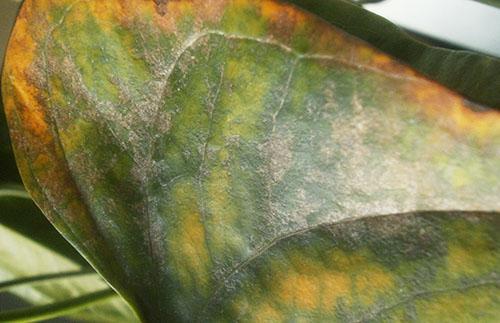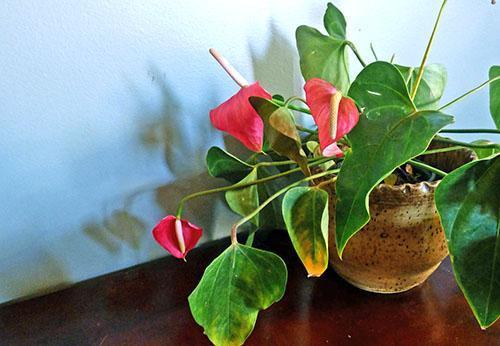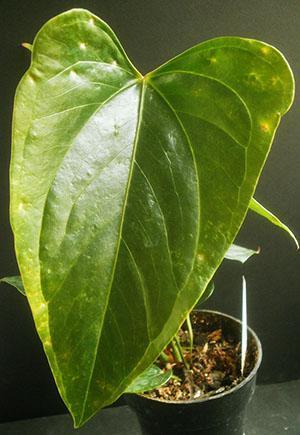Why does your favorite anthurium turn yellow and dry?
 The genus of anthuriums unites from 800 to 1000 plant species, native to the forest regions of Central and South America. The long flowering of certain species and the unusual foliage of others has made many varieties of anthurium popular with indoor florists.
The genus of anthuriums unites from 800 to 1000 plant species, native to the forest regions of Central and South America. The long flowering of certain species and the unusual foliage of others has made many varieties of anthurium popular with indoor florists.
Plants are quite unpretentious, but when growing them, one must not forget that anthuriums are natives of the tropics, where plants do not experience serious temperature changes, rarely suffer from a lack of nutrition and moisture in the soil or air. If the grower manages to properly maintain the growing conditions habitual for anthurium, then the plant responds with good foliage condition, frequent and long flowering.
But how to find out the reason why anthurium turns yellow and dries? Where is the mistake, and which insects can harm the inhabitants of the tropics?
Anthurium dries and turns yellow: content errors

Usually, healthy anthurium has brightly colored shiny or, depending on the species, matte foliage. At the same time, leaf plates are renewed throughout the growing season. Their natural aging and dying off are also accompanied by discoloration, but the process is almost imperceptible. But when the anthurium turns yellow for some external reasons, it is already difficult to pass by the pet's poor health.
All anthuriums grown at home are thermophilic and plants for which the optimum air temperature is 18–26 ° C.
If the temperature background begins to fluctuate sharply or goes beyond the indicated limits, it is worth waiting for the deterioration of the state of the foliage, and with insufficient attention, the roots of anthurium also suffer.
 A drop in air temperature often leaves dark dead marks on the leaves of anthurium. But excessively warm air, especially if the humidity in the room is not too high - this is one of the common reasons why anthurium dries.
A drop in air temperature often leaves dark dead marks on the leaves of anthurium. But excessively warm air, especially if the humidity in the room is not too high - this is one of the common reasons why anthurium dries.
The harmful effects of such conditions are similar to how plants feel on the leaves in direct sunlight, also dangerous for the inhabitants of the moist shady forests of Colombia. Withering and yellowing of anthurium is inevitable when the flower is in the sun for a long time. Therefore, the plants placed on the southern windows must be protected either with a film or other improvised screen.
 But what if the anthurium dries in winter, when the sun is not so bright, and it is warm on the windowsill? Obviously, the problem with such a plant is:
But what if the anthurium dries in winter, when the sun is not so bright, and it is warm on the windowsill? Obviously, the problem with such a plant is:
- lack of light, which can be compensated by installation additional illuminationprolonging daylight hours;
- in excessive dryness of the air, which can be humidified with the help of gentle irrigation of foliage, the use of household appliances and appliances;
- in drafts and streams of cold air coming from the window;
- in a lack of nutrition caused by the lack of feeding or the proliferation of anthurium roots.
In the latter case, it is especially important to help the plant by feeding it or transplanting it into a new fresh substrate.
Features of soil and watering for the health of anthurium
 Actively flowering species of anthurium during the growing season need regular fertilization, which should support both the formation of new buds and the general condition of the anthurium. When choosing a fertilizing agent, it is better to give preference to formulations with a limited amount of nitrogen, which activates the formation of foliage, and an increased content of phosphorus, which is responsible for the quality of flowering.
Actively flowering species of anthurium during the growing season need regular fertilization, which should support both the formation of new buds and the general condition of the anthurium. When choosing a fertilizing agent, it is better to give preference to formulations with a limited amount of nitrogen, which activates the formation of foliage, and an increased content of phosphorus, which is responsible for the quality of flowering.
If the anthurium turns yellow or dries, it may be due to the excess content of nutrients in the soil. In this case, mineral salts that are not absorbed by the roots of anthurium provoke a burn of the underground parts of plants, as well as the active reproduction of pathogenic microflora.
When there is a suspicion that the anthurium is drying out due to an excess of fertilizers, it is necessary to rinse the earthen lump, or transplant the pet into a new substrate.
 A transplant is required when the root system of the plant has completely penetrated the substrate and no longer has free space. This procedure is best done in early spring by transferring the plants to a new, more voluminous pot. But do not forget that anthuriums have a rather effective tool for obtaining nutrition from the atmosphere. These are aerial roots of anthurium, which cannot be removed, but it is more useful to use their susceptibility to foliar dressing and to spraying the crown with clean moisture.
A transplant is required when the root system of the plant has completely penetrated the substrate and no longer has free space. This procedure is best done in early spring by transferring the plants to a new, more voluminous pot. But do not forget that anthuriums have a rather effective tool for obtaining nutrition from the atmosphere. These are aerial roots of anthurium, which cannot be removed, but it is more useful to use their susceptibility to foliar dressing and to spraying the crown with clean moisture.
Fungal and bacterial damage to the roots of anthurium
 But to the excess watering anthurium is extremely negative, and in this case, especially with dense soil, the grower observes not only yellowing and drying foliage. One of the most serious problems for anthurium lovers is the development of root rot, which is facilitated by excessive soil moisture and a lack of oxygen in the soil.
But to the excess watering anthurium is extremely negative, and in this case, especially with dense soil, the grower observes not only yellowing and drying foliage. One of the most serious problems for anthurium lovers is the development of root rot, which is facilitated by excessive soil moisture and a lack of oxygen in the soil.
Root rot on anthurium can be controlled with a wide range of fungicides.
But this measure is not enough. Because it doesn't solve the underlying problem. If the grower has a suspicion that the anthurium dries and turns yellow due to putrefactive processes, the plant must be removed from the pot for inspection and processing.
After cleansing the roots of anthurium from soil residues, the blackened, destroyed areas are cut off and treated with crushed coal, and, if necessary, with fungicides. The plant is transplanted into a new disinfected soil, and the pot itself must be steamed or treated with a solution of potassium permanganate.
Anthurium is difficult to tolerate infectious and fungal diseases. Therefore, it is much easier and more effective to engage in prevention by setting up competent watering and choosing a loose soil mixture for the plant.
Anthurium pests
 One of the reasons why anthurium dries up may be harmful insects that have settled on the plant. Anthurium do not often suffer from any pests, but if yellowed areas are found on the leaves, the surface of the leaf plates has lost its evenness or is already drying up, there is a reason to conduct a thorough inspection of the plant. Pests detected on anthuriums include spider mites, aphids, mealybugs, scale insects and thrips. If the plant is kept in moist soil, mushroom mosquitoes also begin to swirl around the pot.
One of the reasons why anthurium dries up may be harmful insects that have settled on the plant. Anthurium do not often suffer from any pests, but if yellowed areas are found on the leaves, the surface of the leaf plates has lost its evenness or is already drying up, there is a reason to conduct a thorough inspection of the plant. Pests detected on anthuriums include spider mites, aphids, mealybugs, scale insects and thrips. If the plant is kept in moist soil, mushroom mosquitoes also begin to swirl around the pot.
Most of the insects that parasitize plants feed on juices, which is why, with a significant number of pests, anthurium turns yellow and noticeably weakens.
Thrips and mealybugs often live on new shoots and foliage, the same insects, along with aphids, can be found on buds. A sign of the presence of mites on anthurium is a barely noticeable cobweb at the forks of shoots and in the axils.
 The most persistent and vicious occupier is the pest of anthurium and other indoor plants shown in the photo - thrips. The insect feeds on the juices of not only leaves and stems, but also inflorescences, causing damage to stipules and ears.
The most persistent and vicious occupier is the pest of anthurium and other indoor plants shown in the photo - thrips. The insect feeds on the juices of not only leaves and stems, but also inflorescences, causing damage to stipules and ears.
While mealybugs are few in number, they hide under dried leaf scales and in the axils, but, multiplying, they can cover the entire plant, and part of the population also populates the ground.
Green or gray aphids that inhabit anthuriums hide on the back of the leaf plates. As a result of the destructive activity of pests in anthurium, leaves turn yellow and curl, inflorescences dry up.
Many of these pests can be cured by treating the aerial part of the plant with a soap solution obtained from insecticidal or green soap.
True, it should be borne in mind that anthurium pests reside on the plant not only in the form of adult insects, but also eggs and larvae. Gradually hatching generations, if not repeated processing, take up the vacated space and continue to harm the culture.
 In addition, modern insects easily develop immunity to rather weak means. And some varieties, like the shield shown in the photo, are not at all susceptible to such effects. Therefore, the florist should be ready not only to repeatedly irrigate the foliage with soapy water, but also to treat the anthurium with a systemic insecticide. A day after the treatment, the foliage of the anthurium is washed with clean water, carefully covering the soil from excess moisture.
In addition, modern insects easily develop immunity to rather weak means. And some varieties, like the shield shown in the photo, are not at all susceptible to such effects. Therefore, the florist should be ready not only to repeatedly irrigate the foliage with soapy water, but also to treat the anthurium with a systemic insecticide. A day after the treatment, the foliage of the anthurium is washed with clean water, carefully covering the soil from excess moisture.
While pest control is not as laborious as it is with root rot, prevention is always healthier and easier. For example, mites on anthurium, like other species, start in low humidity conditions. And here it is extremely important to be attentive to the care of the indoor plant, as well as to regularly rinse the foliage, which is a prevention against the appearance of pests on the anthurium and helps the plant to breathe.
To prevent the spread of pests to healthy plants, you can quarantine new, recently acquired anthuriums. In 3-4 weeks, you can usually identify all the hidden problems of the green pet, take measures to heal it and not damage the rest of the collection.